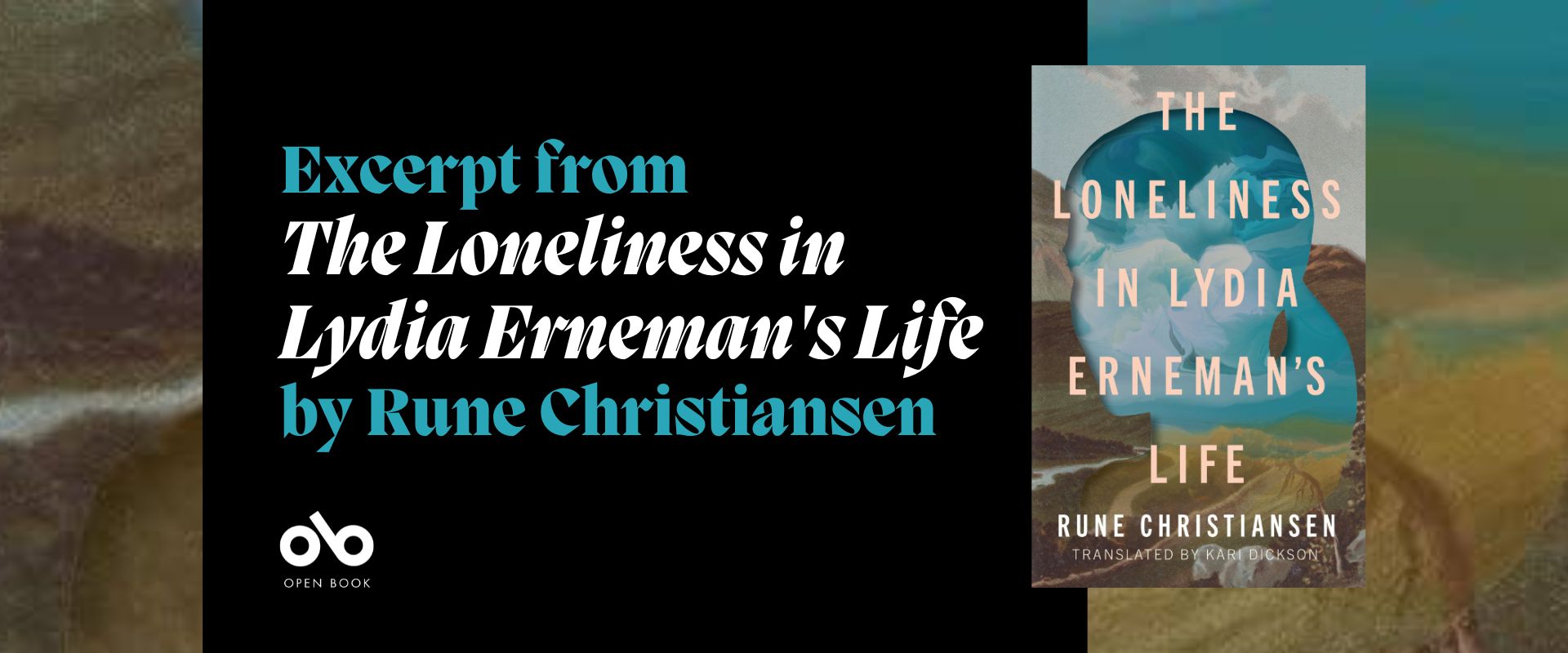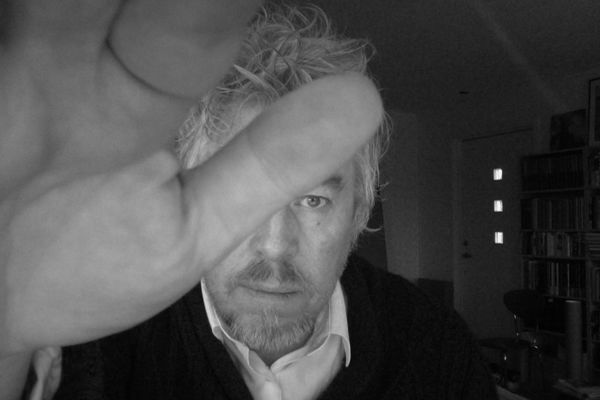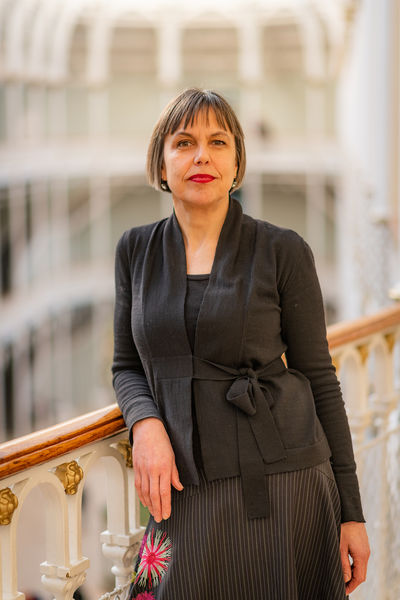Read an Excerpt from The Loneliness in Lydia Erneman's Life by Norwegian Literary Star Rune Christiansen
In an increasingly connected but paradoxically lonelier world, the idea of true solitude is a complex one. Finding contentment in a quiet life seems both dreamlike and untenably isolating to many, and the fine line between solitude and loneliness is often murky and shifting.
It's in this context that Norwegian literary star Rune Christiansen has won universal acclaim for his novel, The Loneliness in Lydia Erneman's Life (Book*hug Press, translated by Kari Dickson). The book tells the story of Lydia, raised as an only child in Northern Sweden. Her quiet childhood morphs into a quiet life as she trains as a vet and settles into her adult years in a rural Norwegian town. She falls in love and visits her aging parents, but her life remains small in scope with a limited cast of characters.
It sounds like the set up for a novel where the next event is something dramatic – a death, a war, a mysterious disappearance. But Christiansen staunchly refuses to take readers where they expect and resists the urge to look away from Lydia's externally simple life. Exploring her vacillating desires as she swings between a longing for further human contact and a contented solitude, Christiansen crafts a rare and gem-like novel that bucks every publishing trend and pressure, expertly navigating, through his short sketch-like segments, the tender rawness and deep humanity of, quite simply, a life, and the rich depths that lurk behind seeming simplicity.
We're sharing a short excerpt from The Loneliness in Lydia Erneman's Life today, courtesy of Book*hug Press. The novel won the Brage Prize, Norway's most prestigious literary award, and in this section we get a glimpse into Christiansen's sparsely elegant prose (here through the talents of English language translator Kari Dickson), which earned the novel its widespread acclaim.
Excerpt from The Loneliness in Lydia Erneman's Life by Rune Christiansen:
Before all else, it should be said that Dagmar Erneman, mother of Lydia Erneman, almost drowned in her late teens when crossing a river on horseback. She had been out for a ride and was going to ford the river at the usual place, but the animal stepped into a hollow between the smooth stones and lost its balance. Dagmar fell under the heavy body, and as they floundered, she hit her head. She was found at dusk by two boys on their way home from a fishing trip. She was lying apparently lifeless on the bank, and the horse was beside her, neighing and pawing the ground with its hooves. It took the boys a few desperate minutes to heave her up across the saddle and take her back to the village. The episode took place in the fifties, in Frankrike in Jämtland, in the north of Sweden, but Dagmar’s daughter, Lydia, did not hear about it until many years later, when she was nineteen and sitting eating with her parents. Her mother had set the table out on the terrace. They helped themselves to food straight from the pans and barely exchanged a word until Lydia announced, unexpectedly, that she was going to move. She had been offered a place at the Swedish University of Agricultural Science in Uppsala down south and wanted to go, as her dream was to become a vet and work with horses, nothing else.
Perhaps it was just natural concern, now that Lydia wanted to leave home, that caused Dagmar to grasp her daughter’s hands across the table and tell her about this experience from her youth. Lydia looked at her mother and said she knew how to look after herself, but then her father, Johan, said so had her mother, she had been around horses since she learned to walk. Despite their opposition, when the autumn came around, Lydia Erneman left the family farm in Krokom. She drove all the way to Uppsala in the south and, in the years that followed, passed her exams with brilliant results. She scarcely had time for love, just the odd half-hearted affair, and days could pass between each time she saw her friends. This was not because she was shy or modest, but rather because she was consumed by her studies and the desire to be finished. She wanted to get on, she said, she wanted to work, she longed to fill her life with this work that she loved. She was neither restless nor unhappy in her own company. In fact, it was not unusual for her to think what a good life she had. Of course, she wished she had someone to share her every day with, someone to give herself up to, but this longing was not such that it diminished her existence in any way. She never had to fear being bored. Was she naive in her enthusiasm? No, she was not naive, she was rather level-headed and stubborn.
Her student years passed without Lydia losing patience for even a moment. She was a non-fighter where others struggled, and this irrepressible joy became her identity— her asset, for want of another word— and when she later applied for a job with the aging vet Carl Magnus Stangel, who ran a prestigious veterinary hospital just outside Tomelilla in Skåne, she already had glowing references from those who had known her at Ultuna, as well as an excellent degree. And Stangel, who trusted his instinct, employed Lydia immediately, almost as soon as he shook her hand. In the weeks that followed, he drove her around the flat, open landscape, so she would get to know the area, and him. It was, for the most part, Stangel who did the talking. Like an Eastern master he told his stories; he spoke at length about the eel’s poisonous blood and the import of Holstein cattle to Skåne in the nineteenth century, he described his childhood in Småland and was more than happy to talk about the wild horses— also known as “the horses from the sea”— in the Camargue, where he had lived in younger years, and how wonderful and white they were. One story led to another, and it was the start of what would prove to be a few rich years for Lydia, there in Österlen. But when Stangel retired, Lydia applied for a job at a private veterinary practice in Norway. The clinic was in a rural location some way from the capital and was run by the vet Sigurd Brandt, a man who was in many ways like Stangel. Having shown Lydia around the district, or “parish,” as he called it, he offered her the job. And so Lydia left southern Sweden and moved to the neighbouring country. She bought an old but well-maintained house with a mature Victorian-style garden, with flowers and herbs and berry bushes. There was also a greenhouse, and a wall to protect the garden from the northerly wind, but no lawn, which suited her fine; instead paved pathways wound between the beds, where everything grew with great vigour. The house was tall and white, with steep gables and a picket fence that ran around the not particularly large property. In spring and summer, grass pushed up against the painted wood, and in winter, the snow was left untouched. But now it was autumn, and orange and red leaves floated, swirled, and rustled in the wind. In October, a hint of melancholy came early on the light morning breeze, and yet Lydia often sat out on the small balcony, particularly in the evening, looking at old reference books or writing a kind of veterinary journal, in what was actually a simple, light blue unlined notebook. She could sit with these worthwhile tasks for hours. If she had a day off, she studied and made notes until dusk fell and the words were barely visible on the page. She swung her feet up onto the railing in the twilight and listened reverently to the constant rustling of the garden. She had a view of a couple of chestnut trees. They had grown tall and wide on either side of the gravel path that led down to the old main road. But every so often, a miserable or childish thought might disturb her. For example, she might get it into her head that her life was made up, that it wasn’t really real. And it is here, following this rather hasty introduction, that the story of Lydia Erneman begins.
____________________________________
Excerpt taken from The Loneliness in Lydia Erneman's Life by Rune Christiansen, translated by Kari Dickson, a novel published by Book*hug Press. Copyright Rune Christiansen, 2023. Reprinted with permission.
Rune Christiansen is a Norwegian poet and novelist. One of Norway’s most important literary writers, he is the author of more than 20 books of fiction, poetry, and nonfiction. He has won many prestigious awards, including the 2014 Brage Prize for his bestselling novel, The Loneliness in Lydia Erneman’s Life. Fanny and the Mystery in the Grieving Forest was shortlisted for the same prize and published in English by Book*hug Press in 2019. He is also a professor of creative writing. Christiansen lives just outside of Oslo, Norway.
Your CanLit News
Subscribe to Open Book’s newsletter to get local book events, literary content, writing tips, and more in your inbox
Kari Dickson is a literary translator. She translates from Norwegian, and her work includes literary fiction, children’s books, theatre, and nonfiction. In 2019, Book*hug Press published her translation of Rune Christiansen’s Fanny and the Mystery in the Grieving Forest, and, in 2021, her co-translation of Mona Høvring’s Because Venus Crossed an Alpine Violet on the Day that I Was Born. She is also an occasional tutor in Norwegian language, literature and translation at the University of Edinburgh, and has worked with the British Centre for Literary Translation (BCLT) and the National Centre for Writing. Dickson lives in Edinburgh, Scotland.






